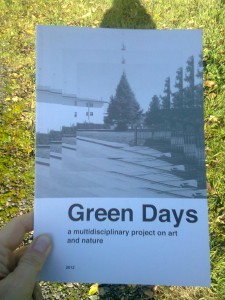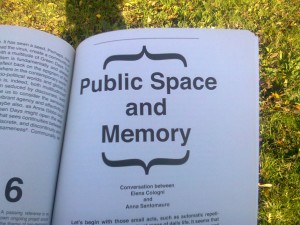Publications
GREEN DAYS
Extract from Anna Santomauro interviewing Elena Cologni
A.S. Let’s begin with those small acts, such as automatic repetitive movements that construct maps of daily life. It seems that the idea of distance, that is, the relationship between here and elsewhere, have changed dramatically in recent years, and with it the perception of places. What do you think are the cognitive impacts at the individual and collective level?
E.C.: I think that the current context produces a sense of alienation in the individual, and this is caused by the dominant technological economy, and based on the urgency to reduce the space/time gap, which is typical of today’s system of communication. Assuming that we all share this experience, ROCKFLUID (https://rockfluid.com) represents an attempt to investigate this by creating opportunities to meet in a shared physical space where we undergo an experience, we walk, we move around a certain place, moving our body in space, thereby re-defining it as our own. I’m interested in this type of activity, in relation to psychogeography too, but more as the adoption of relational tactics,  rather than as an individual activity, and aimed at sharing the creative process with the participants. In fact, their input builds a web of narratives I witness and adopt. I also believe that raising an awareness of how digital time interferes with our perception of time (subjective time) is a driving force behind the work. One way to do this is by breaking the now-established memory/past relationship. Since we are so obsessed with constantly documenting our lives, the impossibility of doing the same with memory may have become a phobia (…), and I thus would like to introduce a new scenario: that we are able to change our memories when they resurface in the present. Aspect I introduced with a previous work of mine (http://www.elenacologni.com/memory) , and which in this context becomes instrumental for a new definition of ‘place’. This is found specifically in the qualities of instability and transition typical of memory. Furthermore, what frightens me (and which I also do), is how we have become used to confusing the illusion of reality with reality itself. I am aware that this may be a controversial thing to say because it’s like saying that interaction through technology is not interaction. So let’s clarify this further. There are two aspects to explore to support my remark: the first relates to how many of us engage in interaction through technology at the same time as, for example, we are on Skype or respond to a message on Facebook… the fact that we can do other things leads us to act in a somewhat schizophrenic manner, which also has a bearing (and this is the second point) on our perception of time or subjective time.
A.S. Going through space implies an evocative, emotional and mnemonic act of appropriation: while on the one hand, in fact, the schizophrenic use of places is a prerogative of contemporary life, on the other, this same attitude leads obsessively to attempts of mapping, collecting traces, documenting, and re-writing. Perhaps this stems from the desire to produce new forms of narrative of reality, or to produce alternative realities. What do you think?
E.C.: The awareness of our position in space in relation to the use of technology has changed our perception of space itself. We’re used to macro-scales (Google Earth), and we don’t consider our proximities as much anymore. In my project I try to get people to understand this by generating micro-geographies, and the relationship of our body with the space that surrounds it, rediscovering the poetics and politics of everyday life. It’s one way of customizing resistance to the global landscape context. Through my work personal space is a non-verbal language of inter-subjective spatiality. I believe that this need to document is rather linked to the unconscious awareness of not being entirely in the know with the perception of reality in the present, precisely because paradoxically we want to document it at that very moment. If I look at the screen of my phone while I take a picture, at that moment I cannot see through my eyes the same thing that I am photographing. I have documented that moment, but I have also lost it for ever. I am interested in working on this paradox and the attraction that it exerts on us. The attempt to build another reality is also linked to the disappointment of the created reality and the continuous search for a new reality (another image)… in a sense it’s what happens in the creative process, it is driven by dissatisfaction.
A.S. Imagine giving birth to a new discipline: individual memory archeology linked to places. It occurs to me that the first layer to be dug up would be that linked to the collective thought which is shared by everybody, and then move on to the perception one derived from the encounter between the senses and objects. Then comes the emotional one, and after that the one for pathways and systems that subject all these aspects to the individual imaginative reinterpretation. What’s art’s place in this scheme? And what short-circuit does this encounter produce?
E.C. The artist listens, but s/he is not a psychologist nor is s/he a priest. It’s a tacit agreement with the participants who know it. They also know that in reality the artist does not listen, but is present and witnesses the moment. Art transforms the essence of these encounters, freeing itself of words and translating what happens into surrounding forms which remain so, continuously in power. In this sense, we’re not talking about further traces, but new realities.
A.S. And if you were to give a definition of “nature”?
E.C. In the traditional sense it implies the difference between what is natural and what is not natural and is artificial. The latter is to be understood in terms of what has been brought into existence by the human consciousness or mind. Or, depending on the context, we can distinguish the term “natural” from what is unnatural, supernatural or synthetic. The problem is that nothing is natural anymore and thus free from human intervention. To the point that, since the time technology enabled communication travels imperceptibly through the air we breathe, that too is altered by it.
GREEN DAYSÂ , project by neoncampobase (Bologna), AAA – Audiovisual Artists Anonymous (Brussels), Radar (Loughborough), Fabrica de Pensule (Cluj-Napoca)
The book can be read here http://www.matildesoligno.net/catalog-published-for-green-days%E2%80%93multidisciplinary-project-on-art-and-nature/

